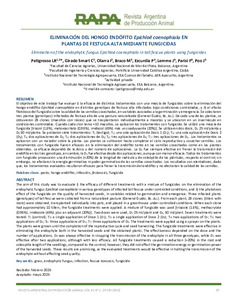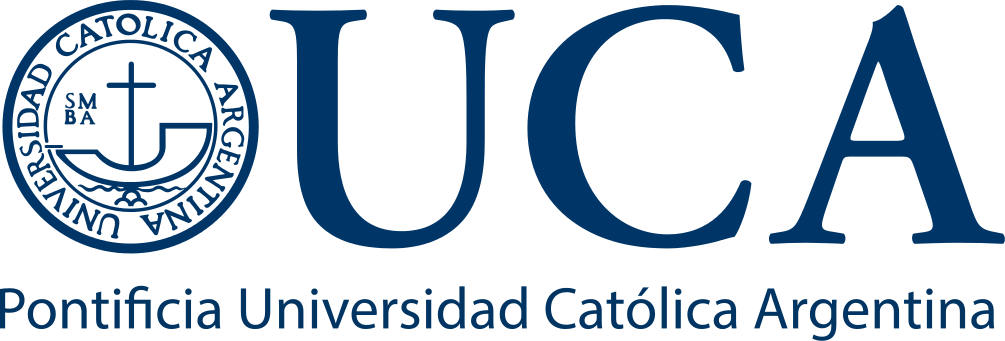Please use this identifier to cite or link to this item:
https://repositorio.uca.edu.ar/handle/123456789/20232| Título: | Eliminación del hongo endófito Epichloë coenophiala en plantas de festuca alta mediante fungicidas Elimination of the endophytic fungus Epichloë coenophiala in tall fescue plants using fungicides |
Autor: | Petigrosso, L. R. Girado Smart, C. Olarra, I. Braco, M. Ezcurdia, P. Lemme, J. Parisi, F. Poo, J. |
Palabras clave: | FUNGICIDAS; HONGOS; FESTUCA; Epichloë coenophiala | Fecha de publicación: | 2025 | Editorial: | Asociación Argentina de Producción Animal | Resumen: | objetivo de este trabajo fue evaluar i) la eficacia de distintos tratamientos con una mezcla de fungicidas sobre la eliminación del hongo endófito Epichloë coenophiala en distintos genotipos de festuca alta infectadas bajo condiciones controladas, y ii) el efecto fitotóxico del fungicida sobre la calidad de las semillas cosechadas, en variables asociadas a la germinación y emergencia. Se colectaron tres plantas (genotipos) infectadas de festuca alta de una pastura naturalizada (General Guido, Bs. As.). De cada una de las plantas, se obtuvieron 28 clones (macollos con raíces) que se trasplantaron individualmente a macetas y se ubicaron en un invernáculo en condiciones controladas. Cuando cada clon tenía ≈10 macollos, se aplicaron los tratamientos con fungicida. Se utilizó una mezcla de fungicida [triazol (1,6%), metoxiacrilato (0,96%), imidazol (45%) más un coadyuvante (20%)]. Se utilizaron dos dosis, D1 25 ml/planta y D2 50 ml/planta. Se probaron siete tratamientos: T1 (testigo); T2: una sola aplicación de Dosis 1 (D1); T3: una sola aplicación de Dosis 2 (D2); T4: dos aplicaciones de D1; T5: dos aplicaciones de D2; T6: tres aplicaciones de D1; T7: tres aplicaciones de D2. Los tratamientos se aplicaron con un rociador sobre la planta. Las plantas se cultivaron hasta completar el ciclo reproductivo y cosechar semillas. Los tratamientos con fungicida fueron eficaces en la eliminación del endófito tanto en las semillas cosechadas como en las plantas obtenidas. La eficacia dependió de la dosis y del número de aplicaciones. La D2 fue siempre efectiva en frenar la transmisión del endófito en los tres genotipos, en cambio, la D1 fue efectiva desde dos aplicaciones, aunque con menor eficacia. Todos los tratamientos con fungicida provocaron una disminución (≈20%) de la longitud de radícula y de coleóptilo de las plántulas, respecto al control; sin embargo, no afectaron la energía germinativa ni poder germinativo de las semillas cosechadas. Los resultados son alentadores, dado que, los tratamientos evaluados resultaron eficaces para frenar la transmisión del endófito y no afectarían la calidad de las semillas. The aim of this study was to evaluate i) the efficacy of different treatments with a mixture of fungicides on the elimination of the endophytic fungus Epichloë coenophiala in various genotypes of infected tall fescue under controlled conditions, and ii) the phytotoxic effect of the fungicide on the quality of harvested seeds, in variables related to germination and emergence. Three infected plants (genotypes) of tall fescue were collected from a naturalized pasture (General Guido, Bs. As.). From each plant, 28 clones (tillers with roots) were obtained, transplanted individually into pots, and placed in a greenhouse under controlled conditions. When each clone had approximately 10 tillers, the fungicide treatments were applied. A mixture of fungicide was used [triazole (1.6%), methacrylate (0.96%), imidazole (45%) plus an adjuvant (20%)]. Two doses were used, D1 25 ml/plant and D2, 50 ml/plant. Seven treatments were tested: T1 (control); T2: a single application of Dose 1 (D1); T3: a single application of Dose 2 (D2); T4: two applications of D1; T5: two applications of D2; T6: three applications of D1; T7: three applications of D2. The treatments were applied using a sprayer on the plants. The plants were grown until the completion of the reproductive cycle and seed harvesting. The fungicide treatments were effective in eliminating the endophyte both in the harvested seeds and the obtained plants. The effectiveness depended on the dose and the number of applications. D2 was always effective in stopping the transmission of the endophyte in all three genotypes, while D1 was effective after two applications, although with less efficacy. All fungicide treatments caused a reduction (≈20%) in the root and coleoptile length of the seedlings, compared to the control; however, they did not affect the germination energy or germination power of the harvested seeds. These results are promising, as the evaluated treatments would be effective in halting the transmission of the endophyte without affecting seed quality. |
URI: | https://repositorio.uca.edu.ar/handle/123456789/20232 | ISSN: | 2314-324X 0326-0550 |
Derechos: | Atribución-NoComercial-CompartirIgual 4.0 Internacional | Fuente: | Revista Argentina de Producción Animal. 45(1), 2025. |
| Appears in Collections: | Artículos |
Files in This Item:
| File | Description | Size | Format | |
|---|---|---|---|---|
| eliminacion-hongo-endofito.pdf | 367,58 kB | Adobe PDF |  View/Open |
This item is licensed under a Creative Commons License

